Penal Institutions (Prisons / Juvenile Prisons / Detention Houses)
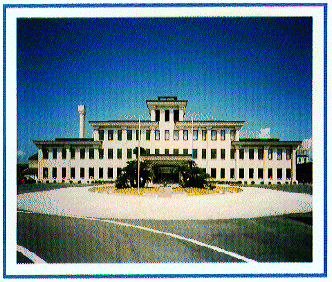
Pamphlet on Penal Institutions in Japan [PDF:20MB]
1. Introduction
The Prison Act, which came into effect with the Penal Code in 1908, was a highly advanced law for its time, even according to international standards, and it took into consideration the humane treatment of inmates living in penal institutions, such as food, hygiene, and medical care, as well as educational concerns for sentenced inmates. However, after World War II, with major reforms to Japan's legal system and legal philosophy, including the establishment of the Constitution of Japan, the theory and practice regarding correctional administration developed significantly. As a result, the Prison Act came to be misaligned with the philosophy of contemporary correctional administration in terms of promoting the inmates' re-entry into society through correctional treatment and stipulating the rights and obligations of inmates. For this reason, penal institution bills, which would amend the Prisons Act, were submitted to the Diet three times since 1982, but the bills could not pass the Diet due to opposition against the substitute prison system. With the deaths and injuries of inmates in Nagoya Prison, which was brought to light from 2002 to 2003, problems in correctional administration concerning the treatment of the sentenced inmates became apparent. The Ministry of Justice launched the Correctional Administration Reform Council, which consisted of private experts with the aim of conducting a broad review of correctional admission reforms. In December 2003, the "Recommendations of the Correctional Administration Reform Council" were made public. In the report, recommendations for various areas of reform were made, and notably, the full and prompt revision of the Prison Act became an integral part of realizing reforms to the correctional administration. In response to the "Recommendations of the Correctional Administration Reform Council", the Ministry of Justice decided to proceed with the revision of the Prison Act. However, since there was opposition to the substitute prison system, the Ministry of Justice first submitted the "Bill on Penal Institutions and the Treatment of Sentenced Inmates" to the Diet in order to completely revise the part of the Prison Act that stipulates the treatment of sentenced inmates. The bill was approved on May 18, 2005, at the 162nd session of the Diet, and entered into effect on May 24, 2006. As a result of this revision, an irrational legal disparity arose between the treatment of sentenced inmates stipulated by the new law and the treatment of unsentenced detainees under the Prison Act. Therefore, the Ministry of Justice proceeded to amend the law concerning the treatment of unsentenced detainees in cooperation with relevant bodies and submitted to the Diet the "Bill for Partial Revision of the Act on Penal Institutions and the Treatment of Sentenced Inmates." The bill was approved on June 2, 2006, at the 164th session of the Diet, and entered into effect on June 1, 2007. As a result of this revision, the name of the act was changed to the "Act on Penal Detention Facilities and Treatment of Inmates and Detainees”. With these revisions, a full revision of the Prison Act was finally realized nearly 100 years since its enactment. Regarding the changes from the Prison Act, please refer to "From the Prison Act to the Act on Penal Detention Facilities and Treatment of Inmates and Detainees." (The texts are available in Japanese) The details of the Act, Cabinet Order and Regulation are published in the following links.
- Act on Penal Detention Facilities and Treatment of Inmates and Detainees (Act No. 50 of May 25, 2005)
- Regulation for Penal Institutions and Treatment of Inmates (Order of the Ministry of Justice No. 57 of May 23, 2006)
2. Outline of Adult Corrections
(1) Organization
In Japan, prisons, juvenile prisons and detention houses are collectively referred to as "penal institutions.” Prisons and juvenile prisons are facilities that mainly accommodate and treat sentenced inmates, while detention houses are facilities that mainly hold unsentenced inmates for whom trials have not been decided.
As of April 2019, the number of penal institutions in Japan totaled 184, with 61 prisons, 6 juvenile prisons, 8 detention houses, 8 prison branches and 101 branch detention houses.
These penal institutions are under the jurisdiction of the Ministry of Justice and are under the supervision of one of its internal departments, the Correction Bureau, and the eight regional correction headquarters which are the field offices.
(2) The Penal Institution Visiting Committee
With the recommendations of the Correctional Administration Reform Council, to establish a third-party committee in each penal institution, a Penal Institution Visiting Committee has been established in each penal institution, based on the "Act on Penal and Detention Facilities and the Treatment of Inmates and Detainees."
The committee is composed of a maximum of 10 members appointed by the Minister of Justice from among those with integrity and insight as well as a passion for improving the administration of penal institutions. The committee monitors the status of the administration of the penal institutions by inspecting the penal institution and holding interviews with the inmates and gives its opinions on the penal institution’s administration to the warden of the penal institution. This allows for the transparency of the correctional administration, the improvement of the administration of the penal institutions, and the enhancement of the partnership between the penal institutions and the communities.
In Japan, prisons, juvenile prisons and detention houses are collectively referred to as "penal institutions.” Prisons and juvenile prisons are facilities that mainly accommodate and treat sentenced inmates, while detention houses are facilities that mainly hold unsentenced inmates for whom trials have not been decided.
As of April 2019, the number of penal institutions in Japan totaled 184, with 61 prisons, 6 juvenile prisons, 8 detention houses, 8 prison branches and 101 branch detention houses.
These penal institutions are under the jurisdiction of the Ministry of Justice and are under the supervision of one of its internal departments, the Correction Bureau, and the eight regional correction headquarters which are the field offices.
(2) The Penal Institution Visiting Committee
With the recommendations of the Correctional Administration Reform Council, to establish a third-party committee in each penal institution, a Penal Institution Visiting Committee has been established in each penal institution, based on the "Act on Penal and Detention Facilities and the Treatment of Inmates and Detainees."
The committee is composed of a maximum of 10 members appointed by the Minister of Justice from among those with integrity and insight as well as a passion for improving the administration of penal institutions. The committee monitors the status of the administration of the penal institutions by inspecting the penal institution and holding interviews with the inmates and gives its opinions on the penal institution’s administration to the warden of the penal institution. This allows for the transparency of the correctional administration, the improvement of the administration of the penal institutions, and the enhancement of the partnership between the penal institutions and the communities.
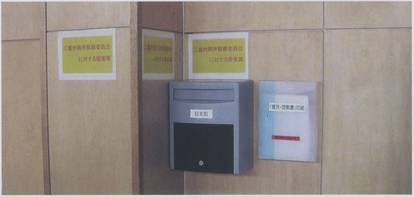
3. Implementation of Correctional Treatment for Sentenced Inmates
(1) Correctional Treatment
The Act on Penal Detention Facilities and the Treatment of Inmates and Detainees provides that treatment of sentenced inmates shall be implemented with the aim of stimulating motivation for reform and rehabilitation and developing adaptability to life in society by working on the inmate’s sense of consciousness in accordance with his or her personality and circumstances.
Correctional treatment of sentenced inmates consists of three main components: work, guidance for reform, and guidance in school courses. These are conducted to achieve the principle of treatment for sentenced inmates.
(2) Prison Work
Prison work allows sentenced inmates to live a well-regulated and diligent life in order to maintain their mental and physical health and to develop their will to work, as well as let inmates become more conscious of their role and responsibility in a well-regulated community life. It further aims to encourage re-entry into society by providing them with vocational knowledge and skills. As a form of prison work, penal institutions hold vocational training so that sentenced inmates can acquire licenses and qualifications or vocational knowledge and techniques. Work is also conducted to cultivate sociability, where sentenced inmates are allowed to work outside the walls of the penal institution, or commute to a business establishment outside the penal institution and work in an office without being escorted by penal staff members.
Click here for more information on prison work.
(3) Guidance for Reform
Guidance for reform is provided in order to encourage sentenced inmates to take responsibility for their crime, and to acquire the knowledge and lifestyle necessary for adapting themselves to life in society. The guidance for reform consists of general guidance for all sentenced inmates and special guidance for sentenced inmates who are deemed to have special problems with reform and rehabilitation or smooth re-entry into society due to specific circumstances. In particular, special guidance for reform consists of guidance for overcoming drug addiction, guidance for withdrawal from organized crime groups, re-offending prevention guidance for sex offenders, education from the victim’s viewpoint, traffic safety guidance, and job assistance guidance.
The Act on Penal Detention Facilities and the Treatment of Inmates and Detainees provides that treatment of sentenced inmates shall be implemented with the aim of stimulating motivation for reform and rehabilitation and developing adaptability to life in society by working on the inmate’s sense of consciousness in accordance with his or her personality and circumstances.
Correctional treatment of sentenced inmates consists of three main components: work, guidance for reform, and guidance in school courses. These are conducted to achieve the principle of treatment for sentenced inmates.
(2) Prison Work
Prison work allows sentenced inmates to live a well-regulated and diligent life in order to maintain their mental and physical health and to develop their will to work, as well as let inmates become more conscious of their role and responsibility in a well-regulated community life. It further aims to encourage re-entry into society by providing them with vocational knowledge and skills. As a form of prison work, penal institutions hold vocational training so that sentenced inmates can acquire licenses and qualifications or vocational knowledge and techniques. Work is also conducted to cultivate sociability, where sentenced inmates are allowed to work outside the walls of the penal institution, or commute to a business establishment outside the penal institution and work in an office without being escorted by penal staff members.
Click here for more information on prison work.
(3) Guidance for Reform
Guidance for reform is provided in order to encourage sentenced inmates to take responsibility for their crime, and to acquire the knowledge and lifestyle necessary for adapting themselves to life in society. The guidance for reform consists of general guidance for all sentenced inmates and special guidance for sentenced inmates who are deemed to have special problems with reform and rehabilitation or smooth re-entry into society due to specific circumstances. In particular, special guidance for reform consists of guidance for overcoming drug addiction, guidance for withdrawal from organized crime groups, re-offending prevention guidance for sex offenders, education from the victim’s viewpoint, traffic safety guidance, and job assistance guidance.
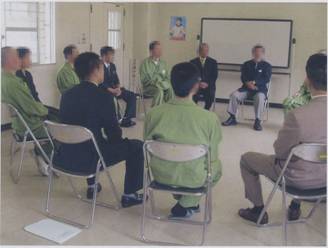
(4) Guidance in School Courses
A considerable number of sentenced inmates are poor in academic performance, including some dropouts from compulsory education or underachievers even if they have completed their education. The penal institution provides guidance in school courses of elementary school and junior high school for sentenced inmates who are deemed to have problems with reform and rehabilitation or smooth re-entry into society due to a lack of an academic background fundamental to life in society. The penal institution may provide guidance in school courses of high school or university for sentenced inmates whose progress in studies has been deemed conducive to his/her smooth re-entry into society.
A considerable number of sentenced inmates are poor in academic performance, including some dropouts from compulsory education or underachievers even if they have completed their education. The penal institution provides guidance in school courses of elementary school and junior high school for sentenced inmates who are deemed to have problems with reform and rehabilitation or smooth re-entry into society due to a lack of an academic background fundamental to life in society. The penal institution may provide guidance in school courses of high school or university for sentenced inmates whose progress in studies has been deemed conducive to his/her smooth re-entry into society.
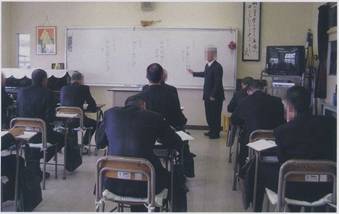
(5) Alleviation of Restrictions and Privilege Measures
In order to cultivate self-reliance and self-control of the sentenced inmates, restrictions on their lives and activities for maintaining discipline and order in the penal institution are alleviated in phases according to the degree of willingness for reform and rehabilitation and the ability to adapt to life in society. This system is called the “alleviation of restrictions.” Sentenced inmates are assigned a restriction level from 1 to 4, and the facilities and methods of treatment are alleviated according to his/her restriction level.
Sentenced inmates are assigned a privilege level from 1 to 5 based on a relatively short-term assessment of their attitude toward their sentence, and in accordance with the privilege level, privilege measures, such as an increase in the number of contacts with the outside world and in the range of usable, self-supplied items, are given. This system is called “privilege measures”. Privilege measures are intended to encourage the sentenced inmates’ willingness for reform and rehabilitation by giving better treatment to sentenced inmates displaying good behavior.
(6) Commuting to Outside Work, Day Leave, and Overnight Stays
The "commuting to outside work, day leave, and overnight stays" system is established in order to encourage the reform and rehabilitation of the sentenced inmates and their smooth re-entry into society. If deemed necessary for a smooth re-entry into society, sentenced inmates placed in an open-type institution or those whose parole has already been decided may commute to a business establishment outside the penal institution without being escorted by penal staff members to engage in outside work, or undergo vocational training or be permitted day leave and overnight stays.
In order to cultivate self-reliance and self-control of the sentenced inmates, restrictions on their lives and activities for maintaining discipline and order in the penal institution are alleviated in phases according to the degree of willingness for reform and rehabilitation and the ability to adapt to life in society. This system is called the “alleviation of restrictions.” Sentenced inmates are assigned a restriction level from 1 to 4, and the facilities and methods of treatment are alleviated according to his/her restriction level.
Sentenced inmates are assigned a privilege level from 1 to 5 based on a relatively short-term assessment of their attitude toward their sentence, and in accordance with the privilege level, privilege measures, such as an increase in the number of contacts with the outside world and in the range of usable, self-supplied items, are given. This system is called “privilege measures”. Privilege measures are intended to encourage the sentenced inmates’ willingness for reform and rehabilitation by giving better treatment to sentenced inmates displaying good behavior.
(6) Commuting to Outside Work, Day Leave, and Overnight Stays
The "commuting to outside work, day leave, and overnight stays" system is established in order to encourage the reform and rehabilitation of the sentenced inmates and their smooth re-entry into society. If deemed necessary for a smooth re-entry into society, sentenced inmates placed in an open-type institution or those whose parole has already been decided may commute to a business establishment outside the penal institution without being escorted by penal staff members to engage in outside work, or undergo vocational training or be permitted day leave and overnight stays.
-
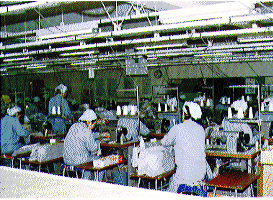
Women's prison
4. Assistance with Leisure Activities
In the penal institutions, intellectual, educational and recreational activities, sports competitions, etc. are carried out for the inmates during leisure time.
For these activities, the support of private collaborators in various fields is indispensable. Here, we introduce some of the people who have collaborated with the penal institutions in Japan.
For these activities, the support of private collaborators in various fields is indispensable. Here, we introduce some of the people who have collaborated with the penal institutions in Japan.
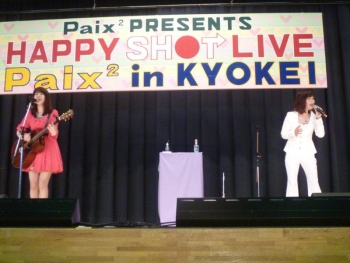
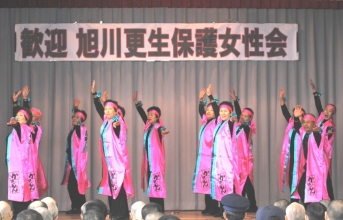
-
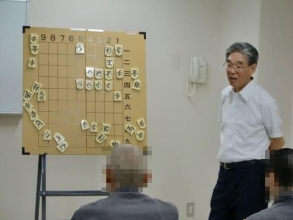
Shogi Club -
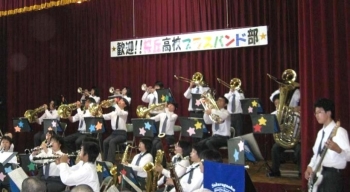
High School Brass Band Club
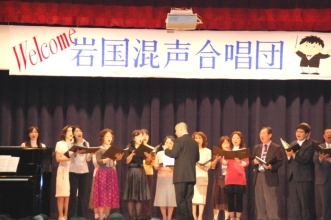
○ Click here for the activity status
Status on Club Activities, etc. [PDF] Status of Visitation Events [PDF]
Status on Club Activities, etc. [PDF] Status of Visitation Events [PDF]

